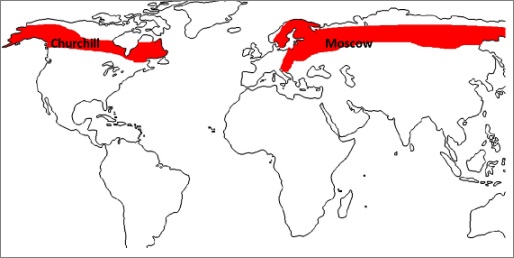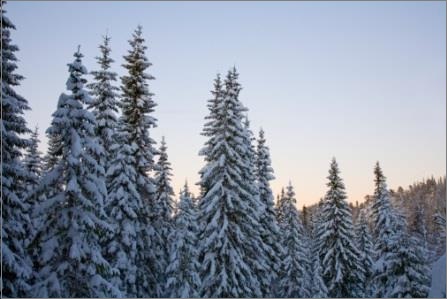Siberian Climate – Cool Temperate Continental – Taiga Climate
by Devender
0 2556
This type of climate is only present in the N-Hemisphere, where the continents within the high latitudes have a broad east-west spread. On its poleward side, it merges into the Arctic tundra of Canada & Eurasia around the Arctic Circle. The climate becomes less severe as we travel southward and fades away into the temperate Steppe Climate.
Siberian Climate – Cool Temperate Continental – Taiga Climate
Evergreen coniferous forests are the predominant vegetation of this type of climate. These forests stretch in a great, continuous belt across North America, Europe, and Asia. The greatest single band of the coniferous forest is Taiga in Siberia. Taiga is a Russian word for coniferous forest.
In Europe, these forests and climate are mainly confined to North Europe, Finland, and Sweden. However, at altitudes in Germany, Poland, Austria, Switzerland, and other parts of Europe there are a small number of coniferous forests.
- The sub-arctic belt in North America stretches from Alaska across Canada into Labrador
- It is found in the high Rocky Mountains further south
- This type of climate is totally absent in the S-Hemisphere
- It is because of the narrowness of the southern continents in high latitudes
- Siberian Climate:
- The annual range of temperature is quite high in this type of climate because of the extremes of temperatures
- The temperature in winters is well below the freezing point
- The temperature in summers is approx. 15 Degree Celsius
- Heavy snowfall occurs with frost as early as August
- Total rainfall in this climate type is around 40 to 60 cm
- It is well distributed throughout the year
- The rainfall is maximum during summer when the continental interiors are greatly heated approx. 20 Degree C
- Natural vegetation:
- USSR, USA, Canada, and Fennoscandian countries (Finland, Sweden, and Norway) are the world's greatest softwood producers
- The USA is the leading producer of wood pulp
- Canada accounts for almost half of the world's newsprint production
- Coniferous Evergreen Forests:
- The trees also offer little grip to the winds
- These trees don't replace their leaves annually like deciduous trees
- The same leaves remain on the tree for as long as 5 years
- The soils of these forests are poor, podzolized, highly leached and very acidic
- The evergreen leaves provide very little leaf fall
- So, the humus formation is very low
- Also, the rate of decomposition of these leathery leaves is very slow
- Agricultural Developments:
- Paper and Pulp industry
- Industrial raw material for making various products such as matches
- For making plywood, hardboards, furniture, toys, planks and packing cases
- For making chemical processed articles such as rayon turpentine, paints, dyes, wood alcohol, disinfectants and cosmetics

The severity of the winters is reduced due to the strong oceanic influences. The coniferous forests are only found on the mountainous uplands of southern Chile, New Zealand, Tasmania, and southeast Australia.
The Siberian climate type is equipped with bitterly cold winters and cool brief summers. It lies across 60 Degree N of the equator and the autumn and spring are just brief transitional periods.
Most of the lakes and ponds get frozen by September and the number of days in which the rivers freeze increases from south to north. The annual precipitation is not high because the interiors of the Eurasian continent are so remote from maritime influence.
Any accumulation of snow is melted with the return of spring and warm summer. Hence, there is the absence of permanent snowfields such as the Alps or the Himalayas. The frozen rivers get defrosted causing a rise in the water level. It sometimes also results in floods.
The presence of a thick mantle of snow protects the soil of the ground from severe cold above which is approx. 5 to 10 Degree C colder as it is a poor conductor of heat. When the snow melts in spring, it also provides moisture for vegetation.
Conifers are the only trees that can adapt and withstand this type of inhospitable environment. The richest sources of softwood are the coniferous belts of Eurasia and North America. These are used in construction, furniture, matches, paper, pulp, rayon, and other chemical products.

The heights of these forests are uniform, the trees grow up instead of out to prevent snow accumulation. The trees grow straight and tall up to approx. height of 100 feet. There are majorly 4 types of conifers that are – Fir, Pine, Spruces and Larch.
The trees keep their leaves to quickly begin food production as soon as warm weather returns in the spring. The needle-shaped leaves have a way of coating to reduce moisture loss in cold weather. These narrow needles have very low surface area for the drying winds of winters. These trees store their food in trunks and the bark of these trees is thick to protect the trees from excessive cold.
The absence of direct sunlight and short duration of summer along with the above-mentioned factors doesn't allow much growth.
The conifers are limited in species with pine, spruce, and fir. They are predominant in the northern forests and larch is predominant in the warmer south. They occur in homogenous groups and are not mixed as tropical forests. It saves a lot of cost and time while enhancing the value commercially of felled timber.
The coniferous forests are felled and transported to the sawmills where the extraction of softwood is done. It forms the basis of the lumbering industry and it is used for a variety of purposes such as -
For extracting fur, the trapping of fur-bearing animals is practised on a large scale as it fetches huge prices. Some cereals such as barley, oat, rye, and root crops like potatoes are raised only in the more sheltered valleys and land-boarding the steppes but only for local needs.

Share:







Comments
Waiting for your comments